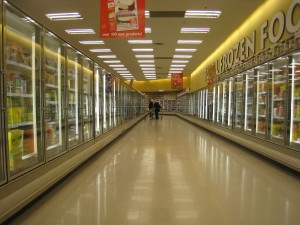The pictures of rotting and mouldy food in different stages of decay are engaging, repugnant and entertaining all at the same time. Curious?
Welcome to One Third – a series of portraits by Austrian photographer Klaus Pichler that reflect the culture of food waste in industrialized nations.
The name One Third refers to the amount of food that is wasted worldwide, according to a study by the Food and Agriculture Organization of the United Nations (FAO).
The 2011 study, Global Food Losses and Food Waste, revealed that 1.3 billion tons of food produced for human consumption is lost or wasted globally — roughly one third of all food produced. This means that all the resources used up to produce and transport that food are also wasted.
Where does the loss occur? Food is lost throughout the supply chain. Interestingly, where the loss occurs seems to depend on the wealth of the country.
In low-to-medium income countries, loss occurs in the early stages of the supply chain: during harvesting, storing, refrigeration and transportation.
In medium-to-high income countries (Europe, North America), food is wasted in the later stages of the supply chain: this can be due to a lack of coordination between the different players in the supply chain, the buying practices of super-markets, which tend to over buy and overstock so that store shelves offer a constant cornucopia of selection, and consumer behavior (you and me), which demands perfect looking food and wastes good food simply because it can afford to.
Each image in One Third depicts food that was once beautiful, tasty and edible (fruits, vegetables, grains), but has become inedible. The items all come from different parts of the world, travel different distances, and are produced with different methods… with only one thing in common: they arrive in our stores, we buy them and then throw them away.
Bon appétit!
I am tired of people complaining about the cost of food. I know, I sound like a terrible human being. Yes, prices are going up, and of course food has to be affordable. But we are pretty spoiled here in North America compared to the rest of the world when it comes to many things, and the price of food is no exception.
Take a minute to consider how much (or little) of our income that we actually spend on food compared to other nations:
• USA 9.6%
• UK 11%
• Japan 17%
• South Africa 27%
• India 53%
If you’re in North America, you’re spending less than 10% of your income on food. This figure used to be much higher. But believe it or not, it has been steadily decreasing over the past 90 years.
And now, after all this time, the landscape is changing.
The UN Food and Agriculture Organization (FAO), led by newly appointed Jose Graziano da Silva, says the increase is due to bad weather (droughts and floods in food producing areas), high demand, and a switch to higher protein diets. There was much talk about food shortages in 2009, and in February 2011, the FAO Food Price Index reached an all time high — this is a measure of the monthly change in international food commodity prices.
Mr. Graziona says prices are going to stay high — and volatile. And volatily, he says, is worse than high prices, because farmers are hesitant to invest in agriculture for fear of not making their return. Graziano partly blames this volatility on the “financialization” of key commodities by financial markets, i.e. speculation.
The price of food in Canada is rising, but we will not likely feel it until the end of the year, when according to the Globe & Mail — the rising cost of wheat, soy, corn, sugar and vegetable oil will have trickled down and be reflected in supermarket prices.
The UN points the finger for all this at the rising cost of crude oil. While it’s true the cost of wheat has doubled, the cost of wheat makes up only 15 cents of the price of a loaf of bread. The rest comes from processing, packaging, overhead and transportation.
Rising fuel prices are much more of a factor. 1L gasoline is up by 20% from last year, and the price of diesel, used by most transport trucks, is up 30% from last year. This will have a major trickle down effect on… well, everything.
So what can you do to minimize the strain? There are different ideas out there floating around. Start growing your own food during the warmer months to reduce food bills. Buy as local as you can to minimize the distance the food must travel. Buy food that has as little processing and refining as possible — to avoid the costs that each of these stages adds on.
One piece of advice was deceptively simple and made me laugh:
Use all the plant. Save the bones for soup. Freeze and can and jam and pickle the food you do have to stretch it as far as it will go — because the current lifestyle to which we have become accustomed may well be changing.

